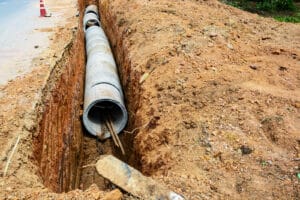I’ve taught a lot of excavation competent person training classes over the years, and more times than not I get the following question: “Trenches and other excavations are permit-required confined spaces, right?”
While a trench or other excavation may seem to fit within the definition of a confined space per the Federal OSHA permit-required confined space entry standards, the answer is “No, trenches and other excavations are not regulated by OSHA as permit-required confined spaces”. However, employers are still required to follow certain precautions spelled out in the OSHA excavation standard (Subpart P) that are similar to those required when we conduct work inside a permit-required confined space; we just don’t have to utilize a permit.
First of all, why do I say a trench or other excavation is not regulated as a permit-required confined space? Because Federal OSHA clearly tells us they are not. OSHA did us all a big favor and clearly stated their stance on this confusing issue when they published their new confined spaces in construction standard in 2015. Paragraph 1926.1201 of that Federal OSHA confined spaces in construction standard sets the scope of the standard, and paragraph (b) of that section spells out the exceptions to the confined space standard. And paragraph (b) clearly states that this standard does not apply to construction work regulated by 1926 subpart P—Excavations.

However, employers must keep in mind that it is possible to have a confined space present inside of an excavation, and entry into that confined space could be regulated by OSHA’s permit-required confined space standard. For example, you could have a trench that runs several hundred feet long (not a confined space), the install a new 30-inch diameter pipeline inside that trench and tie it into the sewer; that new 30-inch pipeline (and the existing sewer) would be regulated as a permit-required confined space. But work conducted in the trench itself (outside of the pipe) is not.
But sometimes there is a potential for a hazardous atmosphere inside of a trench or other excavation. In those situations, employers must ensure their workers follow precautions outlined in the OSHA excavation standards when they enter those excavations to perform work. Examples of such situations include, but are not limited to:
- Trenches cut near landfills (possibility of methane gas seeping onto the space);
- Excavations cut near underground tanks or pipelines that have been leaking for an extended period of time (the chemicals could start to volatize when exposed to sunlight and warmth);
- Tapping/tying into an existing sewer line inside of a trench to make a connection (release of methane gas and possibly H2S); and,
- Use of tools and equipment that run on combustion engines is utilized inside of a trench (gasoline powered saws, generators, and compactors are a few items that come to mind).
In situations where the potential for a hazardous atmosphere exist inside an excavation, such as those listed above, Federal OSHA’s excavation standard 1926.651(g) requires that the atmosphere be tested before employees enter excavations greater than four (4) feet in depth. And if a hazardous atmosphere is found to exist (or if one is reasonably expected to exist), then the employer must take precautions to protect workers inside the excavation, such as but not limited to use of ventilation equipment, respiratory equipment, rescue equipment, and continued monitoring of the atmosphere while work is being performed. All steps very much like those we take when working inside of a permit-required confined space, but without the permit.
Do not think I am trying to discourage employers from going above and beyond and treating all excavations as permit-required confined spaces. If that is the direction you choose to go and it works for you, more power to you. My goal is merely to clarify what the OSHA regulations do and do not require when work is performed inside of trenches and other excavations so employers can make informed decisions about what is required of them.
Do you or treat excavations as permit-required confined spaces? Or do you follow the rules of the OSHA excavation standard instead? Or perhaps all of this is news to you, and you have not been following any rules when working inside of excavations? Let us know your experiences and thoughts on this subject in the “Comments” section of this post. And last but not least, I would like to encourage you to Share this Blog post with others in your Network who might benefit from reading this information. Thank you – Curtis


4 thoughts on “Are Trenches & Other Excavations Permit-required Confined Spaces?”
Would it be considered a confined space to be in a 6’ tall manhole barrel in a 5’ deep excavation that is not yet backfilled? Work being performed is grouting of pipe into manhole and installation of steps.
Hello Don. Thank you for your question. Excavations are exempted from the scope of the confined space standard. So, work in the excavation but outside of the manhole barrel is not considered confined space work. However, the inside of the manhole barrel is considered a confined space, so work inside of there is covered by the confined space standard. Keep in mind, though, that even though the inside of the manhole barrel is a confined space, it may or may not be considered a permit required confined space, as that depends on the presence (or not) of any actual or potential serious safety or health hazard. More info about what is considered a permit space is available in our online confined space training courses. Hope this helps!
Great answer Curtis!
Thxs Herb